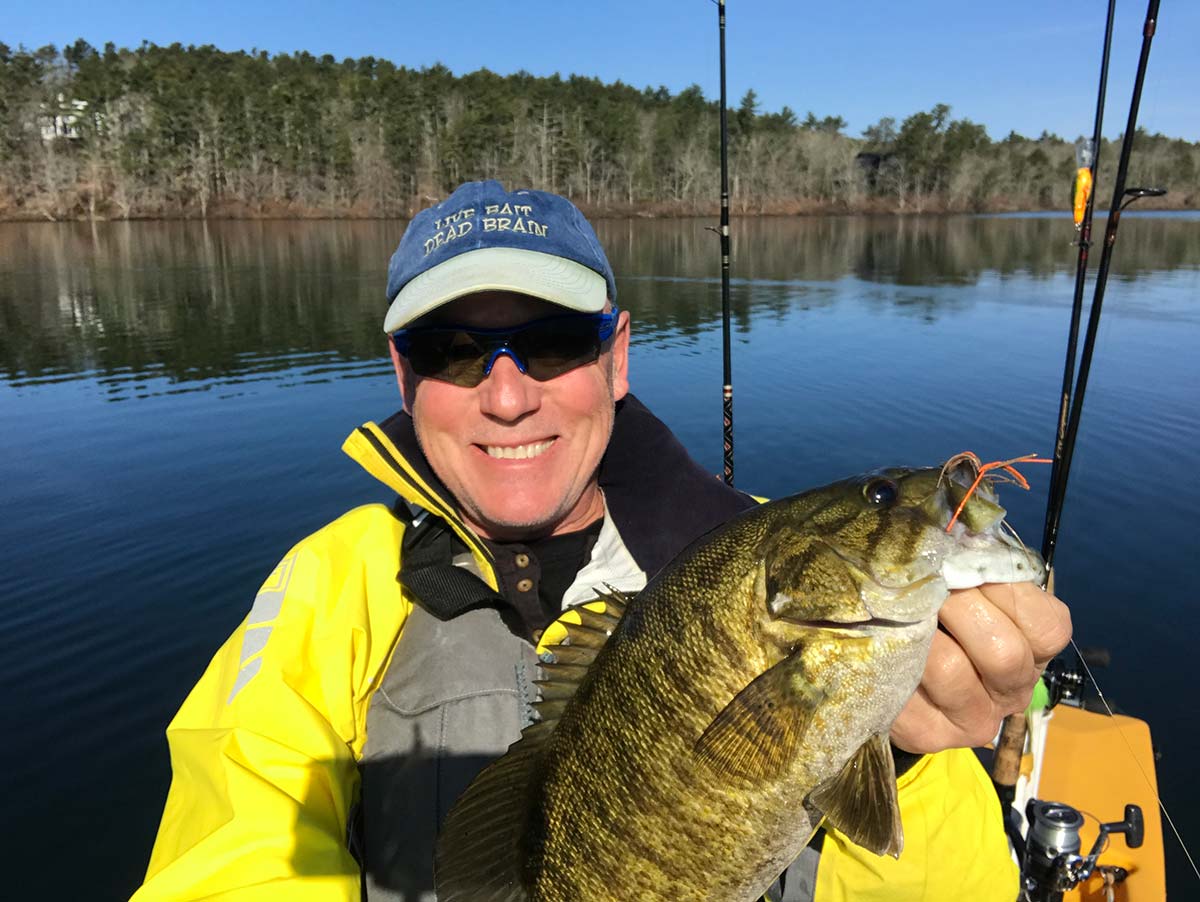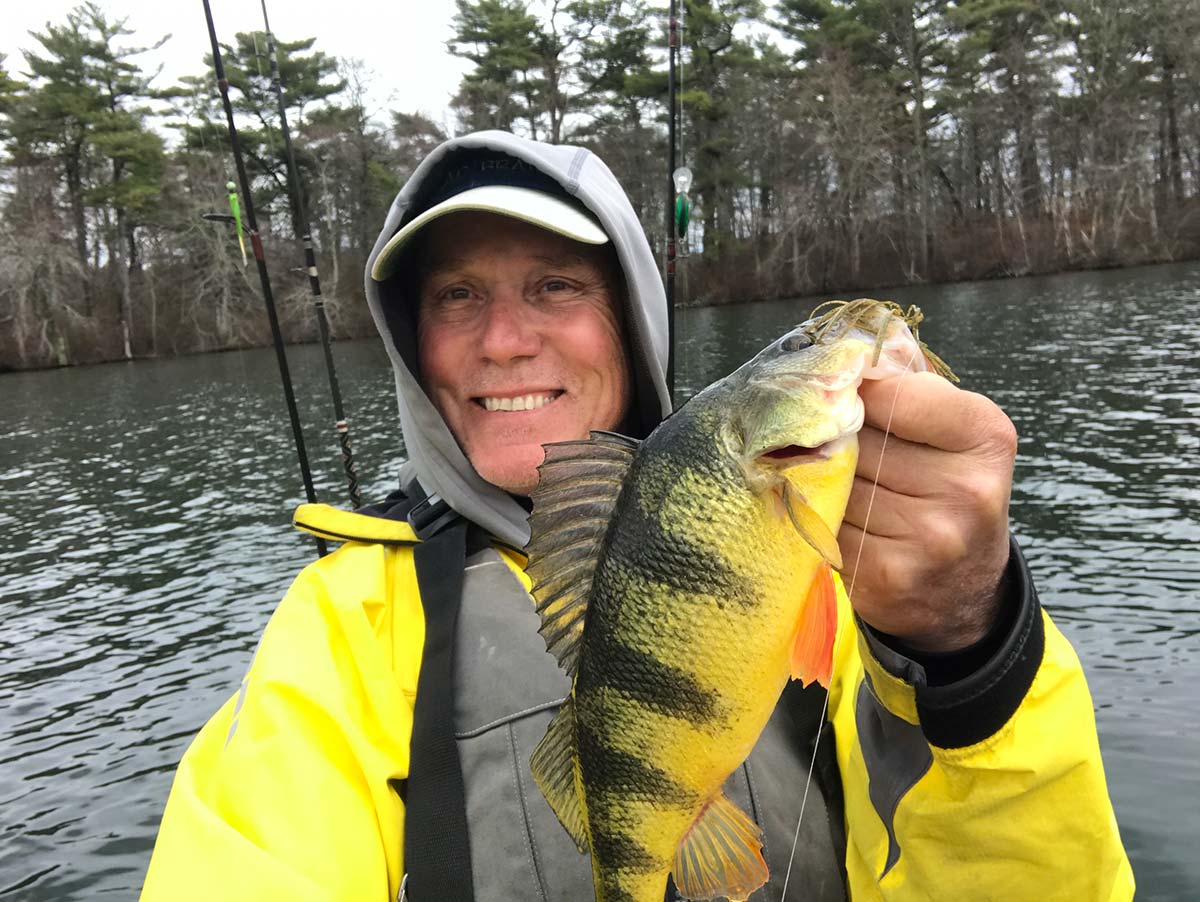
From ice-out to the spring spawn and beyond, the classic hair jig produces on a wide variety of freshwater species.
Like many diehard saltwater fishermen, when winter begins to loosen its icy grip I begin dreaming of the fast-approaching return of striped bass followed by delicious black sea bass. However, this wait for spring saltwater action would be torture if not for some freshwater fishing as a warmup.
If I were to choose one lure to start every freshwater fishing season, it would be an easy decision: the versatile hair jig. I typically start right after ice-out and always have one tied on up until bass start to bed. When water is cold after ice-out, and on until it reaches the low to mid 50’s, my go-to technique is the float and fly.
Much has been written about this specialized technique over the years, but most articles I read back in the early 80’s when I first began thinking about the tactic were geared towards southern smallmouth fisheries. In fact, an article I read a long time back in Bassmaster Magazine by Charlie Nuchols got me thinking about applying it to my largemouth fishing during cold water or tough bites in my home waters. In some recent online correspondence through a smallmouth fishing internet message board I was told that Charlie did not invent the rig, he simply perfected it and certainly was a master at its marketing. It was relayed to me that some folks down south didn’t appreciate the fact that he got so much attention for bringing someone else’s technique to the masses without giving credit to its creators. But, hey they didn’t have the motivation to try and make a dollar with it and Charlie did.

The reality is that the ‘Float and Fly’ had been around for many years prior to Charlie popularizing the technique. It originated as a way to catch crappie in the cold, winter months with small jigs and minnows. I experimented unsuccessfully early one spring with this combo, but like any new technique success breeds confidence and it wasn’t until later that season in November that l saw the true potential for the rig. With cold air and water temperatures hovering at a frosty 49 degrees, my rod and gun club pond was my destination of choice because historically in late fall largemouth bass would stack up in very predictable spots, and its smaller size would provide some shelter from the wind.
After blowing through a dozen live shiners in a little over an hour while anchored up on a point bordering the main pond and a weedy back cove, I switched to throwing suspending crankbaits with limited success. After trying a few other finesse tactics with minimal success, I decided to give the Float & Fly a shot; boy was I amazed as I was almost able to duplicate the catch rate I had experienced earlier with live bait.
This technique continued to prove itself time and time again when the water was cold, bass were extremely pressured or conditions were tough. The rig really shines when it comes to catching quality smallmouth bass in early spring and late fall; however, it is also an extremely effective technique for largemouth, pickerel, crappie, bluegill and trout. I even caught a few winter holdover stripers one cold day on the rig, just to prove it could be done!
Some of the larger fishing mail order catalogs offer Float & Fly kits, but in general, I’ve been very disappointed with the quality of the included hooks as many are geared towards the aforementioned crappie fishing. A good quality, fine-wire hook insures a good hookset on subtle cold-water bites, and many of the commercially available jigs use either too heavy a hook, or if they are fine wire they aren’t sufficient quality to tame large bass. I advise buying jigs with quality 2/0 hooks, and after much experimenting, I have found that 1/8-ounce heads to be the sweet spot. If you tie your own, I recommend Owner or Gamakatsu jigs; both produce high quality fine wire hooks in these weights. An easy hook set is almost guaranteed when using a quality hook.
Much has been written about the right color for certain water and sky conditions, but I’ve always been a subscriber to the K.I.S.S. (keep it simple stupid) principle. I find that simple ties with natural bucktail in brown, black or olive work extremely well. I like them tied so the bucktail is about twice the length of the hook, with an overall length around 2 to 2.5 inches.
For floats my preference is a 4-3/8 inch Thill center slider balsa slip bobber and with light jigs as the 7-foot, light-action rod I prefer when fishing hair jigs throws these lighter rigs with ease. Action should be medium light; stay away from fast actions and look for a more parabolic rod rated for 1/8- to 3/8-ounce and 6- to 15-pound line. I spool up a light spinning reel with 6- or 8-pound mono as it works through the bobber far easier than light braid. There are a number of different style bobber stops available, and I’ve found that the yarn stops work the best as they don’t walk up and down the line excessively when reeled in past the rod tip and are easy to adjust for depth. To rig run your mono through the bobber stop and slide it up your line, run the line through the slip bobber, tie on a jig, set the bobber stop to the depth desired and you’re ready to go. If you have a small bottle of scent to further dress up your jig, all the better!
Set the bobber stop to suspend the jig just off the bottom, the top of the weed bed or the depth you think fish are suspended at. Put a couple of drops of your favorite scent on the jig and let her fly. The best action is no action at all, but in flat conditions, I work the bobber ever so slowly back to the boat with slight rod twitches, often letting the jig sit for minutes between movements. In a slight chop, let the wave action work the jig up and down, moving it only occasionally to change position.
Patience is the name of the game, especially in cold water when this rig works best. Let the rig sit for a minute or two then move it a foot or two with subtle rod tip movements to give the jig a little action. Continue to repeat this process until you are out of the strike zone, but I can’t over emphasis the importance of going extremely slow. Staying focused on the bobber at all times is extremely important as well. Yes, there are strikes that are easy to detect with the bobber being pulled completely under the surface, but quite often the bobber suddenly lays flat on the water, indicating a fish has taken the jig. In cold water hook sets don’t need to be hard, raising the rod usually does the trick; there is no need for that ‘cross their eyes’ hook set which is so popular on the bass shows.

Remember also that with any light line fishing, it’s important to check your line and retie often. After a few larger fish, I re-tie and adjust the depth of the jig. If your water has a good population of pickerel, which my usual starting pond does, be prepared to lose a few jigs, but in cold water you will be surprised at how few jigs you lose to pickerel.
As for where to fish, it really depends on your body of water; early and later in the fall I target weed beds that might still have some life as it will attract the same small baitfish this presentation mimics. Don’t be afraid to go shallow either; one of my better early spring river systems has a shallow cove that is so weed-choked in the summer that there is little open water, but in early spring before the lily pads start to send shoots up from the bottom, it is a killer spot for crappie and largemouth.
As waters warm in the late spring, fish stage in the usual spots like just outside of spawning coves and on warm, sunny days they seek out the shallows; that’s when it gets really fun. Like any fishing technique a little experimentation is needed to see what mood the fish are in, but a more active lift-drop-retrieve will attract a multitude of species in this warmer water. Fronts, overcast skies, wind, time of day and pressure will of course impact how aggressive you can be with the retrieve. Early on between really cold water and spawning temperatures, slower retrieves typically get more attention, but as temperatures warm to a point bass are thinking about spawning, retrieves can be fairly brisk and at times swimming the jig with an occasional pause will generate some violent strikes.
Don’t think this rig is suitable for only small bass and crappie, I’ve caught numerous bass and pickerel over 4 pounds on this rig, with my largest in 2018 a trophy 7.5-pound largemouth bass! It works extremely well for cold water smallmouth and largemouth bass, pickerel, perch and crappie. One of the joys of this technique is the variety of fish you will catch.
One of the intangible rewards to mastering this technique is that it instantly connected me back to my youth and those wonderful memories of waiting patiently for my bobber to go down. It’s a wonderfully relaxing way to start your season, watching patiently for the bobber to telegraph a subtle hit, wondering as you set whether it’s a crappie or a nice bass. Next time you’re challenged with cold water and slow fishing, consider the old reliable hair jig!



